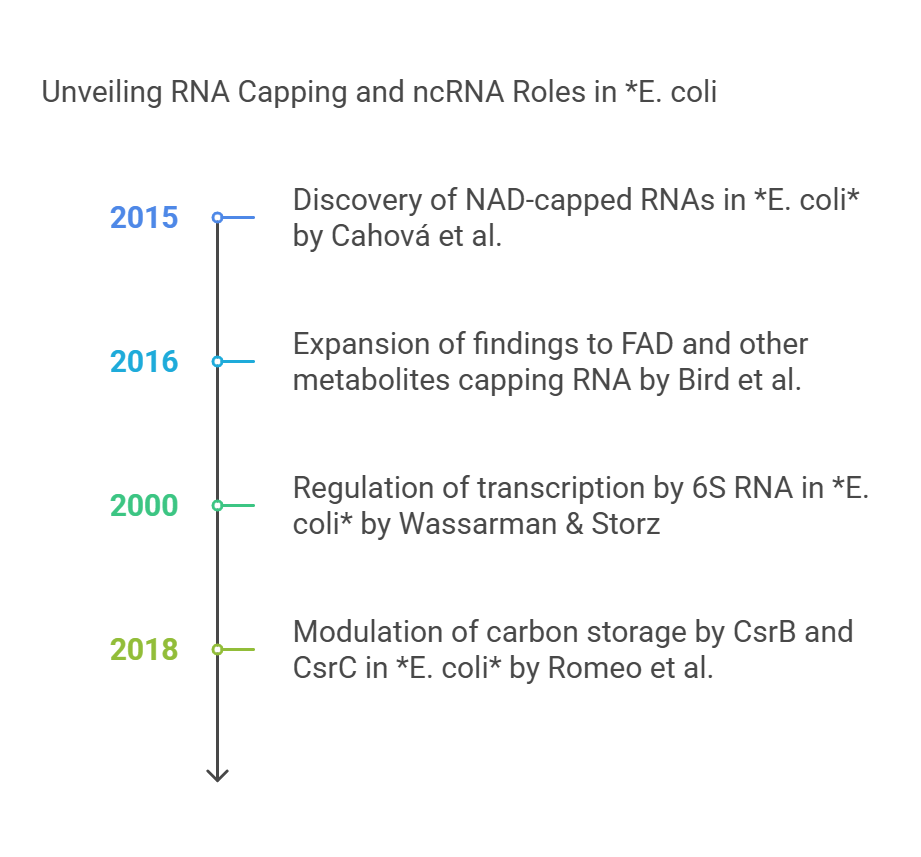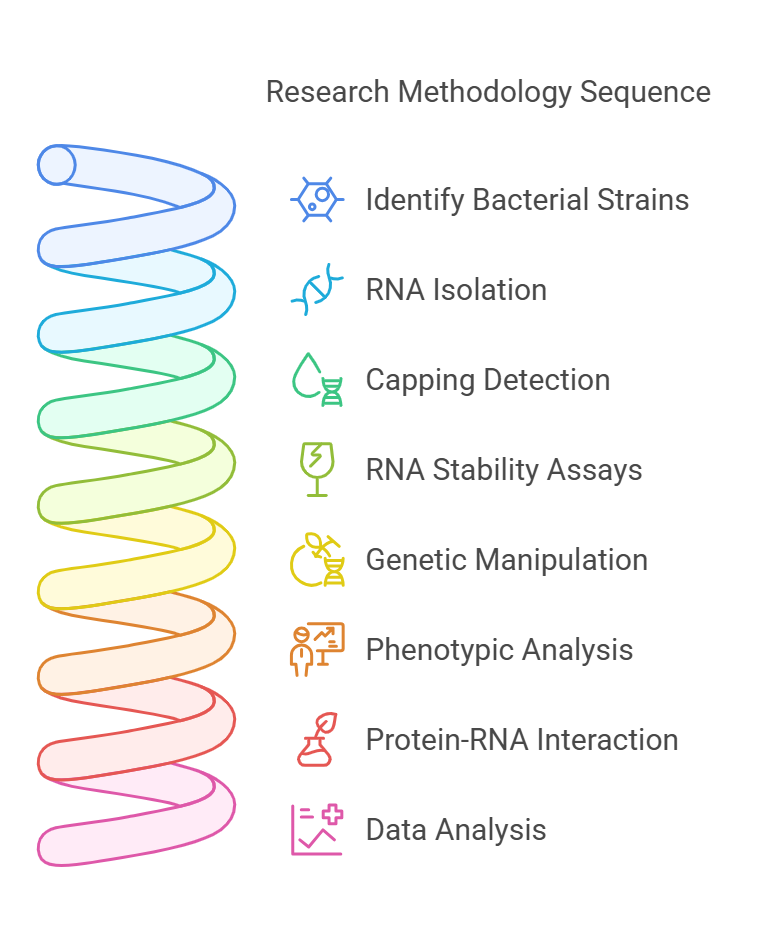Role of RNA Capping in Regulation of E. coli Metabolism
Introduction
RNA capping is a crucial post-transcriptional modification that plays a fundamental role in RNA stability, translation efficiency, and overall cellular function. In eukaryotes, the well-characterized canonical 5’ cap structure (m7GpppN) protects mRNA from degradation and facilitates efficient translation. However, recent advancements in RNA biology have uncovered the presence of noncanonical 5’ capping mechanisms in prokaryotic organisms, including Escherichia coli (E. coli).
Unlike eukaryotic caps, these bacterial RNA molecules are capped with metabolites such as nicotinamide adenine dinucleotide (NAD) and flavin adenine dinucleotide (FAD), suggesting a potential link between RNA function and cellular metabolism (Cahová et al., 2015; Bird et al., 2016). While the discovery of these metabolite caps has expanded our understanding of bacterial RNA regulation, their specific functional roles in gene expression, metabolic pathways, and stress response remain largely unexplored.
Non-coding RNAs (ncRNAs) in E. coli serve as essential regulators of various cellular processes, including growth control, metabolic homeostasis, and carbon storage (Waters & Storz, 2009). The capping of these regulatory RNAs with NAD and FAD may represent an additional layer of post-transcriptional control, potentially modulating RNA stability, processing, or interaction with proteins.
By investigating the functional significance of 5’ metabolite capping in key ncRNAs, this research aims to unravel novel regulatory mechanisms that integrate cellular metabolic states with gene expression. A deeper understanding of this process could provide new insights into bacterial adaptation, stress responses, and potential biotechnological applications in microbial engineering.
Literature Review

RNA Capping in Prokaryotes
For many years, RNA capping was believed to be an exclusive feature of eukaryotic cells, where the 5′ cap structure (m7GpppN) plays a crucial role in mRNA stability, translation initiation, and protection from exonucleases. However, groundbreaking research in recent years has revealed that certain prokaryotic RNAs also undergo noncanonical 5’ capping, challenging the traditional understanding of RNA processing in bacteria.
The first major discovery of noncanonical RNA capping in prokaryotes was made by Cahová et al. (2015), who identified NAD-capped RNAs in Escherichia coli (E. coli). This study demonstrated that NAD capping is not merely an incidental modification but actively influences RNA stability and degradation. The presence of NAD at the 5′ end of bacterial RNAs suggested a potential regulatory role, possibly linking RNA metabolism with the cell’s redox state and energy balance.
Building on these findings, Bird et al. (2016) expanded the scope of noncanonical capping in prokaryotes by identifying additional metabolite caps, such as flavin adenine dinucleotide (FAD) and other small molecule derivatives. Their work provided compelling evidence that bacterial RNA metabolism is more complex than previously assumed, with these metabolite caps potentially serving as molecular signals that modulate gene expression, RNA stability, and interaction with cellular proteins.
These discoveries have opened up new avenues of research into bacterial RNA biology, raising fundamental questions about the biological significance of noncanonical RNA capping. Further investigation is needed to determine how these modifications impact gene regulation, stress responses, and bacterial adaptation to environmental changes. Understanding these mechanisms could have broader implications for biotechnology, synthetic biology, and antimicrobial development, as targeting metabolite-capped RNAs might offer novel strategies for bacterial control and genetic engineering.
Role of ncRNAs in E. coli Metabolism
Non-coding RNAs (ncRNAs) play a crucial role in regulating gene expression and metabolic pathways in Escherichia coli (E. coli), enabling the bacterium to adapt efficiently to environmental changes. Unlike messenger RNAs (mRNAs), which encode proteins, ncRNAs function as key regulatory molecules that modulate transcription, translation, and protein activity through various mechanisms, including direct RNA-protein interactions and base-pairing with target mRNAs.
One well-characterized ncRNA in E. coli is 6S RNA, which regulates transcription by interacting with RNA polymerase. Wassarman and Storz (2000) demonstrated that 6S RNA binds to the σ⁷⁰-associated RNA polymerase during stationary phase, mimicking an open promoter structure. This interaction inhibits transcription from σ⁷⁰-dependent promoters, allowing E. coli to conserve energy and reprogram its gene expression under nutrient-limited conditions. Upon nutrient availability, 6S RNA is degraded, freeing RNA polymerase to resume normal transcriptional activity.
In addition to transcriptional regulation, ncRNAs also control metabolic processes such as carbon storage. The ncRNAs CsrB and CsrC are central components of the carbon storage regulatory (Csr) system, which governs the balance between energy storage and utilization in E. coli (Romeo et al., 2018). These ncRNAs function by sequestering the RNA-binding protein CsrA, a global regulator that represses genes involved in glycogen biosynthesis while activating genes associated with carbon catabolism. By modulating CsrA activity, CsrB and CsrC help E. coli efficiently allocate resources depending on environmental nutrient availability.
Functional Implications of Metabolite Capping
The discovery of noncanonical RNA capping with metabolites such as nicotinamide adenine dinucleotide (NAD) and flavin adenine dinucleotide (FAD) has opened a new frontier in RNA biology. While the presence of these caps has been documented in various organisms, including Escherichia coli (E. coli), their functional implications remain poorly understood. Current research suggests that metabolite capping may play diverse roles in RNA stability, degradation, and interaction with proteins, but the specific mechanisms and regulatory consequences in E. coli are yet to be fully elucidated.
NAD Capping and RNA Stability
One of the most studied metabolite caps is NAD, which has been shown to influence RNA stability. Jiao et al. (2017) demonstrated that NAD capping can protect RNA molecules from degradation in eukaryotic systems. This protective effect is thought to arise from the structural properties of the NAD cap, which may hinder the binding of exonucleases or other RNA-degrading enzymes. In E. coli, NAD-capped RNAs have been identified, but their stability and degradation kinetics remain unexplored. It is hypothesized that NAD capping could similarly stabilize E. coli ncRNAs, thereby extending their half-life and enhancing their regulatory functions.
FAD Capping and RNA-Protein Interactions
FAD capping, on the other hand, is less well-characterized but is speculated to influence RNA-protein interactions. FAD caps could serve as recognition signals for specific RNA-binding proteins, potentially modulating the formation of ribonucleoprotein (RNP) complexes. In E. coli, such interactions could be critical for the function of ncRNAs involved in metabolic regulation. For example, FAD-capped ncRNAs might interact with regulatory proteins like CsrA, which is known to control carbon storage and utilization (Romeo et al., 2018). However, direct evidence linking FAD capping to specific protein interactions in E. coli is lacking.
Regulatory Roles in E. coli ncRNAs
In E. coli, ncRNAs such as 6S RNA, CsrB, and CsrC play central roles in regulating cellular growth and metabolism. These ncRNAs are known to interact with proteins and other RNAs to modulate gene expression in response to environmental cues (Waters & Storz, 2009). The capping of these ncRNAs with metabolites like NAD and FAD could introduce an additional layer of regulation. For instance:
- NAD capping might stabilize ncRNAs under stress conditions, ensuring their continued function in metabolic adaptation.
- FAD capping could alter the binding affinity of ncRNAs to regulatory proteins, fine-tuning metabolic pathways such as glycogen synthesis or carbon flux.
Despite these intriguing possibilities, the specific regulatory roles of NAD and FAD capping in E. coli ncRNAs remain unexplored. Current studies have primarily focused on the identification of capped RNAs rather than their functional consequences. This gap in knowledge highlights the need for targeted research to uncover the biological significance of metabolite capping in E. coli.
Potential Mechanisms of Action
The mechanisms by which metabolite capping influences RNA function are likely multifaceted. Some proposed mechanisms include:
- Steric hindrance: The bulky structure of NAD or FAD caps could physically block access to RNA-degrading enzymes or ribonucleases.
- Signaling role: Metabolite caps might act as molecular signals, recruiting specific proteins or complexes that recognize the cap structure.
- Metabolic coupling: The presence of NAD or FAD caps could link RNA function to cellular metabolic states, allowing ncRNAs to act as sensors of intracellular metabolite levels.
However, the specific regulatory roles of these caps in E. coli ncRNAs remain unexplored.
Research Gap
Despite the growing evidence of metabolite capping in prokaryotes, there is a significant gap in understanding its biological significance. Specifically, the functional consequences of NAD and FAD capping on E. coli ncRNAs involved in growth and carbon storage regulation are unknown. We seeks to address this gap by characterizing the capping of two key ncRNAs and elucidating its impact on E. coli metabolism.
Also Read About: Plant Science with a focus on small protein.
Hypothesis
We hypothesize that 5’ metabolite capping of E. coli ncRNAs regulates their stability, interaction with proteins, and ultimately their role in cellular growth and carbon storage. Specifically, we propose that NAD and FAD capping modulate the function of these ncRNAs by altering their degradation rates or binding affinity to regulatory proteins.
Objectives
- To identify and characterize NAD and FAD capping on two key E. coli ncRNAs.
- To determine the impact of metabolite capping on the stability and degradation of these ncRNAs.
- To investigate the regulatory consequences of capping on E. coli growth and carbon storage.
- To explore the interaction between capped ncRNAs and metabolic proteins.
Materials and Methods

6.1 Bacterial Strains and Growth Conditions
- E. coli K-12 strains will be used as the model organism.
- Cultures will be grown in LB medium or defined minimal media with varying carbon sources (e.g., glucose, glycerol).
6.2 RNA Isolation and Capping Detection
- Total RNA will be extracted using TRIzol reagent.
- NAD- and FAD-capped RNAs will be enriched using immunoprecipitation with anti-NAD and anti-FAD antibodies (Cahová et al., 2015).
- Capped RNAs will be identified using next-generation sequencing (NGS) techniques, such as NAD captureSeq (Jiao et al., 2017).
6.3 RNA Stability Assays
- RNA half-life will be measured using transcriptional inhibition with rifampicin followed by qRT-PCR.
- Degradation rates of capped vs. uncapped RNAs will be compared.
6.4 Genetic Manipulation
- CRISPR-Cas9 will be used to generate E. coli mutants lacking specific ncRNAs or capping enzymes.
- Complementation assays will be performed to confirm phenotypic effects.
6.5 Phenotypic Analysis
- Growth curves will be monitored using spectrophotometry.
- Carbon storage will be assessed by measuring glycogen and polyhydroxybutyrate (PHB) levels.
6.6 Protein-RNA Interaction Studies
- RNA immunoprecipitation (RIP) will be used to identify proteins binding to capped ncRNAs.
- Mass spectrometry will be employed to characterize these interactions.
6.7 Data Analysis
- Sequencing data will be analyzed using bioinformatics tools.
- Statistical analysis will be performed using GraphPad Prism or R.
Expected Outcomes
- Identification of NAD- and FAD-capped ncRNAs in E. coli.
- Demonstration of the role of capping in RNA stability and degradation.
- Elucidation of the regulatory impact of capping on E. coli growth and carbon storage.
- Discovery of novel protein-RNA interactions mediated by metabolite capping.
Significance
This study will provide novel insights into the role of RNA capping in prokaryotic metabolism. By linking metabolite capping to ncRNA function, the project will advance our understanding of post-transcriptional regulation in E. coli and potentially other bacteria. The findings could also have broader implications for biotechnology and metabolic engineering.
Referencrs
- Bird, J. G., et al. (2016). “The mechanism of RNA 5′ capping with NAD+, NADH, and desphospho-CoA.” Nature, 535(7612), 444–447.
- Cahová, H., et al. (2015). “NAD captureSeq reveals NAD as a 5′ cap for a subset of bacterial RNAs.” Nature, 519(7543), 374–377.
- Jiao, X., et al. (2017). “5′ end nicotinamide adenine dinucleotide cap in human cells promotes RNA decay through DXO-mediated deNADding.” Cell, 168(6), 1015–1027.
- Romeo, T., et al. (2018). “Global regulation by CsrA and its RNA antagonists.” Microbiology Spectrum, 1(2).
- Wassarman, K. M., & Storz, G. (2000). “6S RNA regulates E. coli RNA polymerase activity.” Cell, 101(6), 613–623.
- Waters, L. S., & Storz, G. (2009). “Regulatory RNAs in bacteria.” Cell, 136(4), 615–628.


